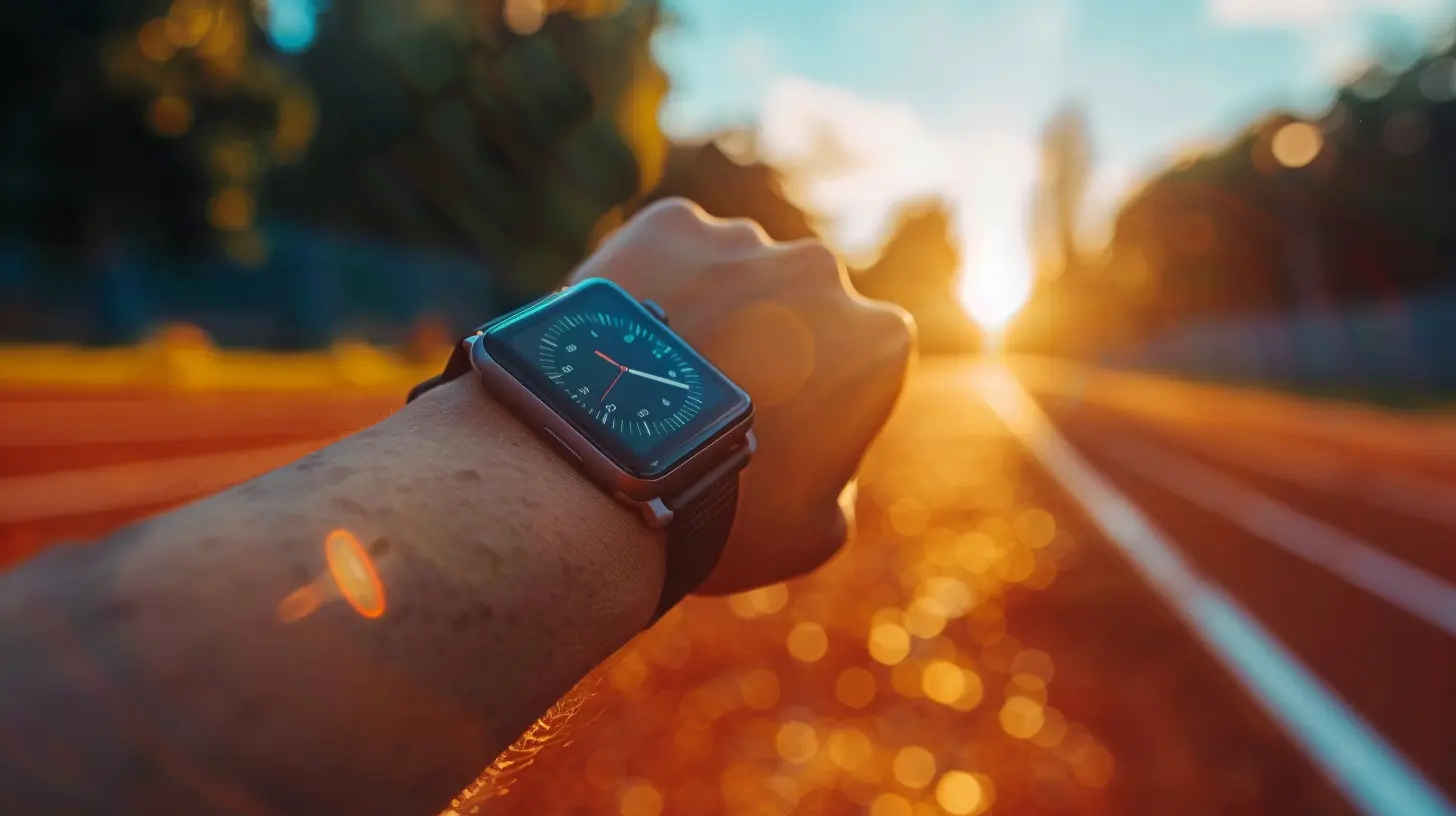How Wearables Are Helping Athletes Avoid Injuries
28 April 2025
In today's fast-paced world of sports, athletes are constantly pushing their limits to achieve peak performance. Whether it's running faster, jumping higher, or throwing farther, the pressure to excel is immense. But as much as athletes strive to perform at their best, there's always the lurking fear of injury. That's where wearable technology steps in. It's changing the game, quite literally, by helping athletes stay healthy and avoid injuries.
You may have noticed more athletes wearing high-tech gadgets on their bodies during games or training sessions. These devices are more than just fancy accessories; they’re becoming essential tools for injury prevention. So, how exactly are wearables helping athletes avoid injuries? Let’s dive in and find out.

What Are Wearables?
Before we get into the nitty-gritty of how these devices are helping athletes, let’s first define what we mean by "wearables." In simple terms, wearables are electronic devices that can be worn on the body. Think of them like mini-computers or sensors that track all kinds of data, from heart rate to muscle activity. These devices can be as simple as a fitness band or as advanced as a full-body suit packed with sensors.Wearables have come a long way in recent years. They’ve evolved from basic pedometers that just counted your steps to more sophisticated gadgets that can monitor nearly every aspect of your physical well-being. And for athletes, this kind of data is pure gold.
Types of Wearables in Sports
When we talk about wearables in sports, there are a few different categories to consider:- Fitness Trackers: These are the most common type of wearables. They monitor basic metrics like heart rate, steps taken, and calories burned. Popular examples include Fitbit and Garmin.
- Smartwatches: Devices like the Apple Watch or Samsung Galaxy Watch not only track fitness metrics but also provide more advanced health insights such as oxygen levels and even ECG readings.
- Smart Clothing: This is where things get really interesting. Imagine wearing a shirt or shorts that can track your muscle activity or a pair of shoes that monitors your foot strike while running. Companies like Hexoskin and Athos are leading the way in this space.
- GPS Trackers: These wearables are often used in team sports like soccer or rugby. They track players' movements in real-time, allowing coaches to monitor their workload and prevent over-exertion.
- Recovery Wearables: Some devices focus on post-activity recovery, like compression garments or even smart patches that monitor hydration levels and muscle recovery.

The Role of Data in Injury Prevention
At the heart of wearable technology is data—loads and loads of it. But what good is all this data if it's not put to use? This is where wearables really shine: they collect data in real-time and provide actionable insights.For example, let’s say you’re a runner. Your wearable might track your running gait, heart rate, and even how much pressure you're putting on each foot. Over time, if the device notices an imbalance in how you're running, it could suggest adjustments to your form to avoid potential injuries. It’s like having a personal coach with you every step of the way.
Real-Time Feedback
One of the biggest advantages of wearables is their ability to provide real-time feedback. Imagine you're in the middle of a workout, and your wearable notices that your heart rate is spiking too high. It can immediately alert you to slow down, potentially preventing you from overexerting yourself, which could lead to muscle strain or more serious injuries.This real-time feedback is especially beneficial in high-intensity sports. For example, in soccer, wearables can track the distance players cover during a match, their top speed, and how often they sprint. If the data shows that a player is pushing too hard, the coach might decide to substitute them to avoid injury.
Identifying Patterns
Another major benefit of wearables is their ability to identify long-term patterns. Over time, athletes and coaches can look at the data to spot trends that may lead to injury. For instance, if a basketball player consistently shows a drop in vertical leap over several weeks, it could be a sign that they’re fatigued and at risk of injury. By addressing these issues early, athletes can take preventive measures such as adjusting their training load or incorporating more recovery time.
Monitoring Workload and Performance
Athletes are always walking a fine line between training hard and overtraining. Too much training can lead to burnout and injury, while too little can result in underperformance. Wearables help athletes find that perfect balance.Training Load
Wearables can monitor an athlete's workload—how much stress they’re putting on their body during a workout or game. This includes everything from the intensity of the workout to the duration of the session. By analyzing this data, athletes can avoid overtraining, which is a leading cause of injuries.For example, in rugby, players often wear GPS trackers during training sessions. These devices track how far players run, how fast they’re moving, and how often they change direction. The data is then used to ensure that players aren’t overexerting themselves, which could lead to muscle strains or other injuries.
Recovery Time
One of the most overlooked aspects of injury prevention is recovery. Wearables can help athletes manage their recovery time effectively by tracking metrics like heart rate variability (HRV) and sleep quality. A lower HRV or poor sleep might indicate that the athlete’s body hasn’t fully recovered from a previous workout. If this goes unnoticed, the athlete may be at a higher risk of injury.For instance, a triathlete may use a smartwatch to track their sleep and HRV. If the data shows that they haven’t fully recovered from a previous training session, they might decide to take an extra rest day or adjust their training intensity.

Improving Biomechanics and Form
Proper biomechanics are crucial for preventing injuries, particularly in sports that involve repetitive motions like running, swimming, or cycling. Wearables can help athletes fine-tune their form, reducing the risk of injury.Running Gait Analysis
For runners, poor form can lead to injuries like shin splints, stress fractures, or knee pain. Wearables equipped with motion sensors can analyze a runner's gait, identifying any inefficiencies or imbalances. For instance, if a wearable notices that a runner is landing too heavily on one foot, it can provide feedback on how to adjust their stride to distribute the impact more evenly.Posture Correction
In sports like weightlifting, maintaining proper posture is essential to avoid injury. Wearables like smart belts or straps can monitor an athlete’s posture during lifts. If the device detects poor form, it can vibrate or send an alert, helping the athlete correct their posture in real-time and avoid injury.Injury Recovery and Rehabilitation
In addition to preventing injuries, wearables can also play a crucial role in helping athletes recover from injuries. Traditional rehabilitation methods often rely on subjective feedback from the athlete, but wearables provide objective data that can help guide the recovery process.Tracking Progress
During rehabilitation, wearables can track an athlete’s progress by monitoring key metrics like range of motion, muscle activation, and strength. This allows physical therapists and trainers to adjust the recovery plan based on hard data, ensuring that the athlete is progressing at the right pace and not rushing back into action too soon.Reducing the Risk of Re-injury
One of the biggest concerns for injured athletes is the risk of re-injury. Wearables can help mitigate this risk by monitoring the body’s recovery and providing data on when it’s safe to return to full activity. For example, if a soccer player is recovering from a hamstring injury, a wearable might track the strength and flexibility of the injured muscle. If the data shows that the muscle hasn’t fully recovered, the player can continue with rehabilitation exercises before returning to the field.
The Future of Wearable Tech in Sports
Wearable technology is still in its infancy, but the potential is enormous. As sensors become more advanced and artificial intelligence improves, we can expect wearables to provide even more detailed insights into an athlete's performance and health. In the future, wearables may even be able to predict injuries before they happen, using advanced algorithms to analyze data and identify patterns that signal an increased risk of injury.Imagine a world where athletes never have to worry about injuries because their wearables can alert them to potential problems before they even feel any pain. It might sound like science fiction, but with the rapid advancements in wearable technology, that future might not be too far off.
Final Thoughts
Injuries are an unfortunate part of sports, but wearable technology is making it easier than ever for athletes to avoid them. By providing real-time data, monitoring workload, improving biomechanics, and aiding in recovery, wearables are becoming an invaluable tool for athletes at every level. Whether you're a professional athlete or someone who just enjoys a weekend run, wearables can help you stay healthy and perform at your best.So, the next time you see an athlete wearing a high-tech gadget, remember—it's not just there to look cool. It might just be the reason they’re staying injury-free and crushing their goals.
all images in this post were generated using AI tools
Category:
Wearable TechAuthor:

Vincent Hubbard
Discussion
rate this article
8 comments
Hudson McClintock
This article provides valuable insights into how wearables are revolutionizing athlete training by proactively identifying injury risks. It's encouraging to see technology enhancing performance and promoting health in sports. Thank you for sharing these critical advancements!
May 16, 2025 at 7:22 PM

Vincent Hubbard
Thank you for your thoughtful comment! I'm glad you found the insights valuable—it's exciting to see how technology is paving the way for safer and more effective training for athletes.
Eli McKenzie
While wearables offer promising injury prevention insights, reliance on technology shouldn't overshadow the importance of traditional training and athlete intuition.
May 2, 2025 at 9:03 PM

Vincent Hubbard
Absolutely, balancing technology with traditional training and intuition is crucial for optimal athlete performance and injury prevention.
Storm McCray
Love how wearables are changing the game for athletes! It’s like having a personal coach on your wrist, guiding you to train smart and stay injury-free!
May 1, 2025 at 6:23 PM

Vincent Hubbard
Absolutely! Wearables provide real-time insights that empower athletes to optimize their training while minimizing injury risks. It’s a game-changer!
Zander Jennings
Finally, tech that tells me to stop running!
May 1, 2025 at 12:14 PM

Vincent Hubbard
Exactly! Wearables not only enhance performance but also promote safety by helping us listen to our bodies.
Brigitte Spencer
This article highlights the significant role wearables play in injury prevention for athletes. By providing real-time data on performance and strain levels, these devices empower athletes to make informed decisions about their training. It's a promising development that could revolutionize how we approach athletic training and injury management.
April 29, 2025 at 6:33 PM

Vincent Hubbard
Thank you for your insightful comment! I'm glad you found the article informative. Wearables truly have the potential to transform athletic training and enhance injury prevention.
Mitchell McMillan
Wearables are transforming athletic training by providing real-time data on performance and biomechanics, enabling athletes to make informed decisions that minimize injury risk and enhance longevity in their careers.
April 29, 2025 at 12:40 PM

Vincent Hubbard
Absolutely! Wearables are revolutionizing training by offering essential insights that help athletes optimize their performance and reduce injury risk.
Otis Morales
This article effectively highlights the transformative role of wearables in injury prevention for athletes. However, it could delve deeper into the potential downsides, such as over-reliance on technology and data privacy issues. Striking a balance between innovative tracking and athlete autonomy is crucial for maximizing benefits while minimizing risks.
April 29, 2025 at 3:18 AM

Vincent Hubbard
Thank you for your insightful comment! You're right—addressing the potential downsides of wearables, like over-reliance and data privacy, is essential for a balanced view. I'll consider expanding on those aspects in future discussions.
Iris Williams
Empowering athletes—technology truly saves careers!
April 28, 2025 at 8:25 PM

Vincent Hubbard
Absolutely! Wearable technology plays a crucial role in injury prevention, allowing athletes to monitor their performance and stay healthy.
MORE POSTS

How to Choose Between Pedal-Assist and Throttle-Only E-Bikes

The Role of Wireless Charging in Autonomous Vehicles

E-Bike Trends Shaping the Future of Personal Transportation

The Future of Electric Motorcycles and Scooters

Exploring the Role of Thermal Management in Battery Systems

The Role of Antivirus Software in Protecting Your Devices